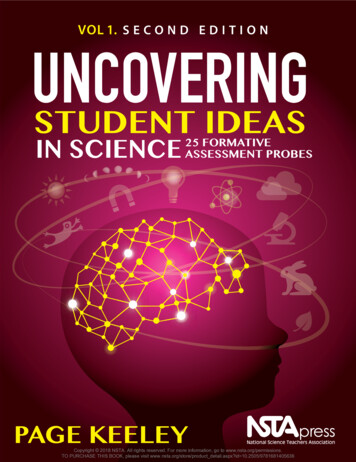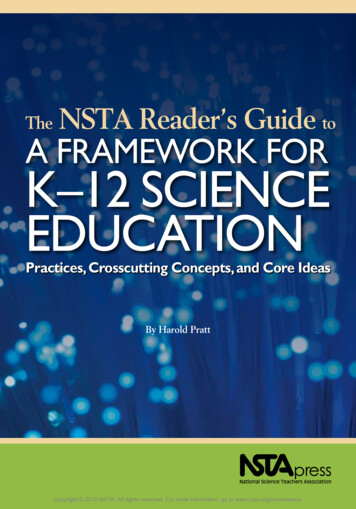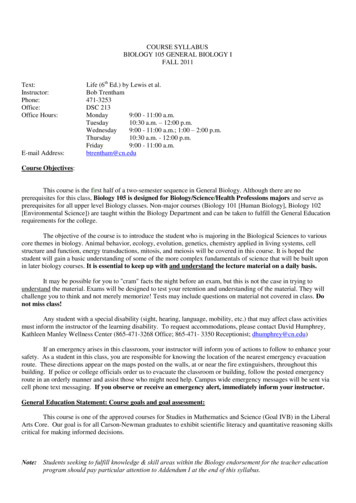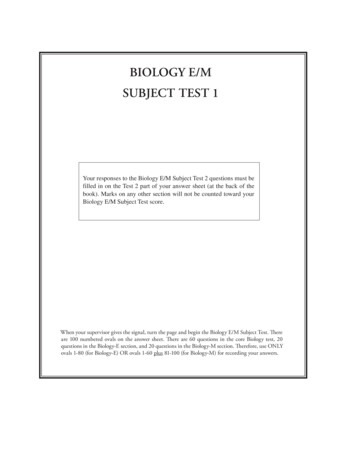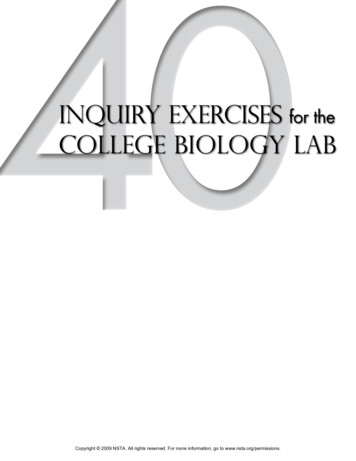
Transcription
40Inquiry Exercises for theCollege Biology LabCopyright 2009 NSTA. All rights reserved. For more information, go to www.nsta.org/permissions.
4Copyright 2009 NSTA. All rights reserved. For more information, go to www.nsta.org/permissions.
40Inquiry Exercises for theCollege Biology LabA. Daniel JohnsonArlington, VirginiaCopyright 2009 NSTA. All rights reserved. For more information, go to www.nsta.org/permissions.
Claire Reinburg, DirectorJennifer Horak, Managing EditorJudy Cusick, Senior EditorAndrew Cocke, Associate EditorBetty Smith, Associate EditorArt and DesignWill Thomas, Jr., Director—Cover and Interior DesignPrinting and ProductionCatherine Lorrain, DirectorNguyet Tran, Assistant Production ManagerNational Science Teachers AssociationFrancis Q. Eberle, PhD, Executive DirectorDavid Beacom, PublisherCopyright 2009 by the National Science Teachers Association.All rights reserved. Printed in the United States of America.11 10 094 3 2 1Library of Congress Cataloging-in-Publication DataJohnson, A. Daniel.40 inquiry exercises for the college biology lab / by A. Daniel Johnson.p. cm.Includes bibliographical references and index.ISBN 978-1-933531-39-71. Biology--Examinations, questions, etc. 2. Biology--Examinations--Study guides. I. Title.II. Title: Forty inquiry exercises for the college biology lab.QH316.J64 2009570.78--dc222008051246NSTA is committed to publishing material that promotes the best in inquiry-based science education. However, conditionsof actual use may vary, and the safety procedures and practices described in this book are intended to serve only as a guide.Additional precautionary measures may be required. NSTA and the authors do not warrant or represent that the proceduresand practices in this book meet any safety code or standard of federal, state, or local regulations. NSTA and the authorsdisclaim any liability for personal injury or damage to property arising out of or relating to the use of this book, includingany of the recommendations, instructions, or materials contained therein.PermissionsYou may photocopy, print, or e-mail up to five copies of an NSTA book chapter for personal use only; this doesnot include display or promotional use. Elementary, middle, and high school teachers only may reproduce asingle NSTA book chapter for classroom or noncommercial, professional-development use only. For permissionto photocopy or use material electronically from this NSTA Press book, please contact the Copyright ClearanceCenter (CCC) (www.copyright.com; 978-750-8400). Please access www.nsta.org/permissions for further informationabout NSTA’s rights and permissions policies.Copyright 2009 NSTA. All rights reserved. For more information, go to www.nsta.org/permissions.
ContentsAcknowledgments. viiPreface.viiiAbout the Author. xivPart IChapter 1. A Brief Introduction to Inquiry. 3Chapter 2. An Outcomes-Oriented Approach to Implementing Inquiry.19Chapter 3. Assessing Inquiry-Based Instruction.39Chapter 4. Teaching Techniques for Inquiry Labs.63Part IIIntroduction to Part II: Tested, Inquiry-Based Laboratory Exercises.81Summary of Units.86Unit 1: Designing Scientific Experiments.93Student Pages.93Teacher Pages. 103Unit 2: Mendelian Genetics. 107Student Pages. 107Teacher Pages. 123Unit 3: DNA Isolation and Analysis. 131Student Pages. 131Teacher Pages. 179Unit 4: Properties of Enzymes. 193Student Pages. 193Teacher Pages. 207Unit 5: Applied Enzymology. 215Student Pages. 215Teacher Pages. 233Unit 6: Energetics and Photosynthesis. 243Student Pages. 243Teacher Pages. 255Unit 7: Signal Transduction. 265Student Pages. 265Teacher Pages. 281Copyright 2009 NSTA. All rights reserved. For more information, go to www.nsta.org/permissions.
Unit 8: Animal Hormones. 293Student Pages. 293Teacher Pages. 307Unit 9: Neuromuscular Control. 313Student Pages. 313Teacher Pages. 329Unit 10: Homeostasis and Heart Rate. 339Student Pages. 339Teacher Pages. 349Unit 11: Metabolism and Oxygen Consumption. 357Student Pages. 357Teacher Pages. 365Unit 12: Transpirational Control. 373Student Pages. 373Teacher Pages. 387Unit 13: Animal Behavior. 395Student Pages. 395Teacher Pages. 405Unit 14: Resource Allocation in Plants. 413Student Pages. 413Teacher Pages. 421Unit 15: Population Ecology. 431Student Pages. 431Teacher Pages. 445Unit 16: Measuring Biological Diversity. 455Student Pages. 455Teacher Pages. 471Appendix A: The Instructional Methods Inventory. 481Appendix B: Sample Form for Students’ Experimental Outline. 487Index . 491Copyright 2009 NSTA. All rights reserved. For more information, go to www.nsta.org/permissions.
AcknowledgmentsIn writing this book, I drew heavily from my own work as a lab developer,coordinator, and instructor. However, one person cannot accomplish a projectthis complex alone. It requires help and support from many others. I wouldlike to thank the 70-plus graduate teaching assistants who led introductorylaboratory courses in the Department of Biology at Wake Forest University from1998 to 2008. They have provided an enormous amount of feedback about theorganization and flow of units and individual exercises. Many of them made suggestions for revisions and improvements, and provided ideas for new exercises ornovel ways to use existing ones that ultimately made it into this book. I also wouldlike to thank the undergraduate students of Wake Forest University for puttingthese units to the ultimate test.I also wish to thank several faculty members of the Department of Biology atWake Forest University for their significant contributions to specific lab units and fortheir support of inquiry-based lab instruction overall: Pat Lord, Brian Tague, CaroleBrowne, and Pete Weigl. I am especially indebted to Herman Eure, former chairof biology and currently dean for faculty development, for his continuous supportand encouragement during our program’s transition to inquiry–based laboratories.My thanks also go to our preparatory staffers—Allen Emory, Gant Hewitt, ShannonMallison, and Mary Tietjen—all of whom helped develop the preparatory notes thataccompany each unit and provided insights for the instructors’ notes.In preparing and sharing parts of this book I have received innumerable helpful comments from reviewers and from instructors at other institutions who haveadapted these exercises to their own classes. Their insights made this a better book,and I sincerely thank them for their contribution. I would also like to thank JudyCusick, Claire Reinburg, and the rest of the editorial staff at NSTA Press for theirinsight and suggestions for improvements and especially for their support of anatypical book such as this.Most of all, I want to thank my long-suffering wife, Bev Nesbit, who has patiently endured the many late nights and working weekends needed to make thisbook a reality.Copyright 2009 NSTA. All rights reserved. For more information, go to www.nsta.org/permissions.
PrefaceIn 1998, the Howard Hughes Medical Institute (HHMI) issued Beyond Bio101:The Transformation of Undergraduate Education. The report outlined severalstrategies used by faculty at various institutions that are changing the wayundergraduate science is taught. The section on laboratory experiences begins with a snapshot of the current situation on many campuses:Biology students approach teaching laboratories with mixed emotions. For some,laboratory courses are windows on the world of science, allowing them to gainexperience with the techniques, concepts, and emotions that go with real research.For others, laboratories are exercises in preordination, a tedious derivation of answers that are already known to questions that do not seem important.Often the best laboratory experience is one in which students pursue theirown research under faculty guidance. In fact, given the success of undergraduate research, more and more faculty members have begun asking: Whynot make teaching laboratories more like research projects? Instead of justshowing students what it is like to do science, why not confront them withreal problems and ask them to come up with their own solutions? (Olsonet al. 1998, p. 30; Howard Hughes Memorial Institute. Used withpermission.)HHMI, the Carnegie Foundation for the Advancement of Teaching, the National Research Council (NRC), and numerous other groups have repeatedlycalled for fundamental changes in how undergraduate biology is taught (Kennyet al. 1998; NRC 2003). Each set of recommendations is based on the same theme:Students learn more, retain knowledge longer, and are better able to apply it ifthey are taught using active, inquiry-based strategies that let them participate inthe discovery of knowledge. The advantages of inquiry-based instructional methods are not just a matter of expert opinion; numerous studies have shown theylead to significantly greater gains in student learning outcomes (for reviews andexamples, see Arce and Betancourt 1997; Bain 2004; Chickering and Gamson 1987;Coppola, Ege, and Lawton 1997; Gardiner 1994; Hofstein and Lunetta 1982; National Institute of Education 1984; NRC 2003; National Survey of Student Engagement 2000).viiiCopyright 2009 NSTA. All rights reserved. For more information, go to www.nsta.org/permissions.
PrefaceUnfortunately, most undergraduates continue to be taught by traditional didacticexposition. They listen passively to lectures, and then in lab perform exercises that reiterate principles they supposedly just learned. Given the evidence that active, inquirybased instructional practices increase learning gains, why do faculty continue to lecture? Why do demonstration-oriented exercises hang on as the dominant style of labinstruction? Some insight can be gained by looking at high school teachers, who haveexperienced similar calls for reform.Efforts to incorporate more inquiry into high school science curricula go backmore than a century. In 1892 the National Education Association (NEA) asked apanel of education leaders to examine the structure, content, and organization ofthe high school curriculum. The “Committee of Ten” (as it came to be called) madenumerous recommendations in its final report. The following excerpt from the report shows that many of its recommendations reflect an inquiry-based approach toteaching science (emphases are this author’s):The Conference on Natural History unanimously agreed that the study ofbotany and zoology ought to be introduced into the primary schools at thevery beginning of the school course, and be pursued steadily. In the nextplace they agreed that in these early lessons in natural science no textbookshould be used; but that the study should constantly be associated withthe study of literature, language, and drawing . Like the report on Physics, Chemistry, and Astronomy, the report on Natural History emphasizesthe absolute necessity of laboratory work by the pupils on plants andanimals, and would have careful drawing insisted on from the beginningof the instruction . [T]he Conference on Natural History recommends thatthe pupils should be made to express themselves clearly and exactly inwords, or by drawings, in describing the objects which they observe .(NEA 1893)Efforts to incorporate more inquiry-based instruction continued through the following century. John Dewey (author of Democracy and Education) called for moreinquiry-based instruction in a 1916 speech to the National Education Association(Dewey 1916). By the 1950s and 1960s, the National Science Foundation had madeprogress toward actually implementing some changes; it sponsored several inquirybased K–12 curriculum improvement projects, including the Biological SciencesCurriculum Study (BSCS), Chemical Education Materials (CHEM) Study, and theScience Curriculum Improvement Study (SCIS). Unfortunately the changes wereshort-lived and fairly localized. By 1980, exposition had returned as the dominantmode of instruction at all grade levels (Hurd et al. 1980).During the 1980s, concerns grew that K–12 students in the United States laggedbehind students in the rest of the world in science and math proficiency (NCEE1982), and from 1989 to 2003, the American Association for the Advancement ofScience and National Research Council repeatedly challenged science educators40Inquiry Exercises for the College Biology LabixCopyright 2009 NSTA. All rights reserved. For more information, go to www.nsta.org/permissions.
Prefacefrom kindergarten through college to integrate active, inquiry-based instructionalmethods into their classrooms (AAAS 1989, 1993; NRC 1996, 1999, 2003). Yet in2005, a survey of state science curriculum standards found that most of the standards still emphasized content coverage; few integrated inquiry-based teaching inany systematic way (Gross et al. 2005). In short, after more than a century of workby education leaders, passive exposition remains the dominant method of instruction for most K–12 programs.Why is there so much resistance to inquiry-based methods? In Science Teachingand Development of Thinking, Lawson (2002) lists 10 reasons precollege instructorscommonly gave for not using inquiry-based teaching methods; most could easilyapply to undergraduate instructors as well. Development and implementation take too much time (the most-citedreason). There is insufficient content coverage. The reading level required is too high/difficult for my students. The risk is too high; I do not know how the instructional units will turnout, and administration will not understand what I am doing and willpenalize me. There are no strong students in the regular biology class (or in the nonmajorscourse for undergraduates). Students are too immature and waste too much time to use it successfully. I have been teaching this way for too long to change now. The textbook/manual/ancillary materials restrict the order in which wecover topics. The students and I are too uncomfortable with it. It is too expensive. My teaching lab is not equipped properly, and there isno budget to buy necessary materials.It has been further suggested that undergraduate instructors are less likelythan high school teachers to adopt inquiry-based instruction because there is lesscentral oversight of the curriculum on the college level (NRC 2003 [especially seereferences]; Tanner and Allen 2006). A central administrative directive for K–12reforms can help ensure that inquiry-based methods will be used systematically inseveral courses or across an entire curriculum. The college-level instructor, on theother hand, must make changes with minimal guidance or support.Because there is no central source for materials and resources that meet thesevarious needs, college instructors must cobble together solutions from a varietyof sources. Simply modifying materials originally designed for high schools isnot a solution because the two audiences are fundamentally different. Students’maturity, intellectual skills, and attention span differ, as do instructional goals.xNational Science Teachers AssociationCopyright 2009 NSTA. All rights reserved. For more information, go to www.nsta.org/permissions.
PrefaceThe number of students served also is a factor. College instructors routinely havedozens to hundreds of students enrolled in a single large introductory course. Theamount of time available for lab-related work also differs greatly.The relative scarcity of resources designed specifically for college instructorsis another source of resistance. There is an immense body of validated curricula,lesson plans, instructional resource guides, textbooks, and lab exercises availableto K–12 instructors. The amount of material developed specifically for college instructors is orders of magnitude smaller.Purpose and Structure of This BookTo incorporate more inquiry at the undergraduate level, faculty need a practicalintroduction to the general theory and best practices of inquiry-based teaching;tools to help them create, administer, and evaluate new inquiry-based coursesand update existing courses so they can follow a more inquiry-based approach;instructional supporting materials designed specifically for their audience; andlaboratory exercises that can be adapted to a variety of inquiry-based teaching andlearning strategies.This book was designed to be a general resource guide for college faculty whowant to add inquiry-based methods to their biology laboratory courses. It focusesmostly on the laboratory setting, but many of the principles and methods describedin Chapters 1–4 can be applied to a variety of course situations. For those who arenew to this topic, Chapters 1, 2, and 4 provide a basic introduction to inquiry as aninstructional practice and offer guidelines for developing an inquiry-based courseusing an outcomes-oriented approach. Chapter 3 reviews assessment methods andprovides guidance in how to teach novice instructors (such as teaching assistants,for example) to use inquiry. Those who are already familiar with these topic areascan skip the early chapters will little loss of continuity.Some readers may want to supplement an existing lab course with just oneor two of these lab units. Others may decide (as the author’s department did) toreorganize their entire lab program around inquiry. Chapter 2 discusses strategiesfor making this transition. Again, I have only provided an overview; details are inreferences at the end of each chapter and unit.The main body of this book consists of 16 modular lab units; some are inquiryoriented adaptations of well-established exercises, while others are entirely new. Anintroduction preceding the units (p. 81) summarizes the differences between themand explains the conventions used. The units are self-contained as much as possible,so they may be arranged in any order. Each unit was developed for students in eithera nonmajor or introductory majors biology course. They span a range of topics andvary in length, overall structure, and difficulty. The Summary of Units on page 86provides information on each unit’s intended audience, model and questions,major concepts, prior skills and knowledge needed, and degree of difficulty.40Inquiry Exercises for the College Biology LabxiCopyright 2009 NSTA. All rights reserved. For more information, go to www.nsta.org/permissions.
PrefaceThe units have undergone extensive testing with undergraduates and been revised repeatedly, so they are very robust. It is important to remember, though, thatevery student group is unique; what one particular audience finds difficult, anothermay find straightforward. Inquiry requires instructors to be flexible and responsiveto students’ needs. Readers should not be afraid to experiment and modify exercisesto fit their particular instructional goals.Each unit contains classroom-ready student exercises, plus Instructors’ Notes andPreparatory Notes. The student exercises are at the level at which they are used at theauthor’s institution. They range in complexity from exercises that are best suited fornonmajors just starting in biology, to exercises designed for majors in sophomore-levelcourses. However, most can be revised to fit a different target audience. The background material that precedes the student exercises has been written so it can be revised, rearranged, or stripped down as needed to fit the target audience and the levelof inquiry and difficulty desired by the instructor.The Instructors’ Notes provide supplemental background information and instructional goals and typical outcomes. They indicate where students may struggle with aunit and suggest how the instructor can guide them. Suggestions for modifying units tofit a range of course formats and audiences are included, as are suggested modificationsif a small lab section (fewer than 12 students) would have difficulty completing a unit.The Preparatory Notes for each unit list specific equipment and quantities of supplies needed for a single lab section of 20 students. Quantities are simply scaled up forlarger or multiple lab sections. Detailed instructions are provided for obtaining andmaintaining model organisms (if any) and for preparing and storing reagents.Key terms and concepts appear in boldface type.ReferencesAmerican Association for the Advancement of Science (AAAS). 1989. Project 2061: Sciencefor all Americans. New York: Oxford University Press.American Association for the Advancement of Science. 1993. Project 2061: Benchmarks forscience literacy. New York: Oxford University Press.Arce, J., and R. Betancourt. 1997. Student-designed experiments in scientific lab instruction.Journal of College Science Teaching 27: 114–118.Bain, K. 2004. What the best college teachers do. Cambridge, MA: Harvard University Press.Chickering, A. W., and Z. F. Gamson. 1987. Seven principles for good practice inundergraduate education. AAHE Bulletin 39: 3–7.Coppola, B. P., S. N. Ege, and R. G. Lawton. 1997. The University of Michigan undergraduatechemistry curriculum: Instructional strategies and assessment. Journal of ChemicalEducation 74: 84–94.Dewey, J. 1916. Method in science teaching. General Science Quarterly 1: 3.Gardiner, L. F. 1994. Redesigning higher education: Producing dramatic gains in student learning.San Francisco: Jossey-Bass.Gross, P. R., U. Goodenough, L. S. Lerner, S. Haack, M. Schwartz, R. Schwartz, and C.E. Finn Jr. 2005. The state of state science standards 2005. Washington, DC: Thomas B.Fordham Institute.xiiNational Science Teachers AssociationCopyright 2009 NSTA. All rights reserved. For more information, go to www.nsta.org/permissions.
PrefaceHofstein, A., and V. N. Lunetta. 1982. The role of the laboratory in science teaching:Neglected aspects of research. Review of Educational Research 52: 201–217.Hurd, P. D., R. W. Bybee, J. B. Kahle, and R. E. Yeager. 1980. Biology education in secondaryschools of the United States. American Biology Teacher 42: 388–410.Kenny, S. S., B. Alberts, W. C. Booth, M. Glaser, C. E. Glassick, S. O. Ikenberry, K. H.Jamieson, R. M. O’Neil, C. Reid-Wallace, C.-L. Tien, and C. N. Yang. 1998. Reinventingundergraduate education: A blueprint for America’s research universities. Stony Brook, NY:Boyer Commission on Educating Undergraduates in the Research University.Lawson, A. E. 2002. Science teaching and development of thinking. Belmont, CA: Wadsworth/Thompson Learning.National Commission on Excellence in Education (NCEE). 1982. A nation at risk: Theimperative for educational reform. Washington, DC: NCEE.National Education Association (NEA). 1893. Report of the commission on secondary schoolstudies. Washington, DC: NEA.National Institute of Education. 1984. Involvement in learning: Realizing the potential ofAmerican higher education. Washington, DC: National Institute of Education.National Research Council (NRC). 1996. National science education standards. Washington,DC: National Academy Press.National Research Council (NRC). 1999. Transforming undergraduate education in science,mathematics, engineering, and technology. Washington, DC: National Academy Press.National Research Council (NRC). 2003. Bio2010: Transforming undergraduate education forfuture research biologists. Washington, DC: National Academies Press.National Survey of Student Engagement. 2000. National benchmarks of effective educationalpractice. Bloomington, IN: Indiana University Center for Post-Secondary Research andPlanning.Olson, S., J. Richardson, J. B. Verringia, and D. Jarmul, eds. 1998. Beyond Bio101: Thetransformation of undergraduate biology education. Chevy Chase, MD: Howard HughesMedical Institute.Tanner, K., and D. Allen. 2006. Approaches to biology teaching and learning: On integratingpedagogical training into the graduate experiences of future science faculty. CBE—LifeSciences Education 5: 1–6.40Inquiry Exercises for the College Biology LabxiiiCopyright 2009 NSTA. All rights reserved. For more information, go to www.nsta.org/permissions.
About the AuthorA.Daniel (Dan) Johnson is a North Carolina native who obtained his BSin biology from the University of North Carolina at Charlotte. Afterthree years in the pharmaceutical industry he entered Wake ForestUniversity School of Medicine where he earned a PhD in cell biologyin 1992. He subsequently completed postdoctoral fellowships at the Texas HeartInstitute in Houston and the University of Virginia in Charlottesville.In 1998 he returned to Wake Forest University, this time to the Department ofBiology as core curriculum coordinator, where he currently holds the rank of senior lecturer. He teaches general biology for nonmajors; introductory cell biologyand physiology courses for premajors; and graduate courses in instructional methods, professional skills development, and bioethics on both the undergraduate andmedical school campuses. He leads faculty development workshops through thecampus Teaching and Learning Center and has served as an instructional methodsconsultant on several awarded national grants. Dr. Johnson is an active memberand regular workshop leader for the Association of Biology Laboratory Education(ABLE), and in 2008 he was voted to its governing board.Dr. Johnson and his wife volunteer their free time to Historic Bethabara Parkin Winston–Salem, North Carolina. They are the principal caretakers for the Hortus Medicus, the
40 inquiry exercises for the college biology lab / by A. Daniel Johnson. p. cm. Includes bibliographical references and index. ISBN 978-1-933531-39-7 1. Biology--Examinations, questions, etc. 2. Biology--Examinations--Study guides. I. Title. II. Title: Forty inquiry exercises for the college



